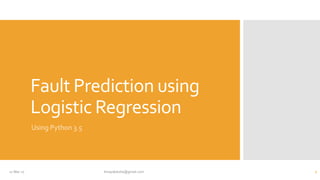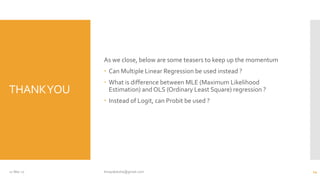Fault prediction using logistic regression (Python)
- 1. Fault Prediction using Logistic Regression Using Python 3.5 17-Mar-17 binayakdutta@gmail.com 1
- 2. Preface This deck illustrates the considerations and method for use of Logistic Regression and analytics in general For the illustration, a hypotheticalWind turbine based electricity generation system is considered along with its associated IT systems The LearningAndTesting Data is mocked up. Range bound random weights are added to mimic natural randomness in data Detailing the Statistics behind the models or the overall data/analytics architecture is not the focus and hence saved for later Python 3.5 along with its libraries (pandas, statsmodels and matplotlib) is used for implementing the regression models 17-Mar-17 binayakdutta@gmail.com 2
- 3. Approach to Modeling Acquire, Prepare, Analyze Select & Develop Model Train,Test & Evaluate Model Implement Model in Solution Re-evaluate & Re-train Model 17-Mar-17 binayakdutta@gmail.com 3
- 4. Problem Statement & Solution Overview WIND TURBINES SENSOR DATA ASSET & WORK MGMT. SYSTEM WEATHER DATA ASSET & INCIDENT DATA DATA PREP. FOR ANALYTICS FAULT PREDICTION ANALYTICS MIS DATA PREVENTIVE ALERTs PREVENTIVE MAINTENANCE INCIDENT & ACTION LOG Problem : ForWind turbines, duration based maintenance policy does not factor the dynamic operational stats. of assets and its ambient conditions. Hence sometimes, the interventions are too early and too late Solution : Preserve data for asset, its condition and fault history as well as weather condition. Build analytic model to learn from past data and predict failures 17-Mar-17 binayakdutta@gmail.com 4
- 5. Acquire, Prepare, Analyze Data In this context, lets assume that following information is available or can be made available Equipment Identifier :Which will uniquely identify an instance of wind turbine EquipmentType : Classifying where wind turbine transmission is Geared or Direct Drive Tower Height : Height of tower (in meters) of the wind turbines Historical Daily Status of Equipment (Operational /Failed). [To be predicted] Weather Data (Temperature andWind Speed) for each Equipment Location can be made available from external sources Further we will assume that All such data sets are available for historical dates and will be available for future dates For our exercise, we will take two sets of data January Data which will be used to train the model (File name = Logit_Wind_Data_Train_File.csv ) February Data which will be used to test the model (File name = Logit_Wind_Data_Test_File.csv ) 17-Mar-17 binayakdutta@gmail.com 5
- 6. Acquire, Prepare, Analyze Data Read and analyze available data points 17-Mar-17 binayakdutta@gmail.com 6
- 7. Acquire, Prepare, Analyze Data • OPS_STATUS, our dependent variable, can take only binary values. For most of records, its UP ( 1 ) while for a small portion its DOWN ( 0 ) • TOWER HEIGHT is spread between 50, 60 and 70 meters • BLADE RPM is spread between 0 to 30 revolutions per minute • TEMPERATURE can fluctuate between 0-60 degrees Celsius • WIND speed is varying between 0-30 meter per second for the given sample 17-Mar-17 binayakdutta@gmail.com 7
- 8. Prepare Data & Develop Model Create dummy variable for categorical attribute Setting up the predictor variables for prediction Set up Logistic Regression Model 17-Mar-17 binayakdutta@gmail.com 8
- 9. Train,Test & Evaluate ModelWith Training and Test DataSets • Lower z-stats and higher p-value for [TOWER-HT] indicates null-hypothesis (suggesting that this predictor does not have significant influence on outcome) • Higher Standard error for [INTERCEPT] indicates high variability in coefficient (possibly suggesting other unidentified predictor variables) • Standard error, z-stat and p-value of other predictors look healthy 17-Mar-17 binayakdutta@gmail.com 9
- 10. Train,Test & Evaluate ModelWith Training and Test DataSets TYPE = GEARED RPM of BLADE TEMPERATURE WIND SPEED INTERCEPT OPS_STATUS close to 1predicting Up & Running OPS_STATUS close to 0predicting potential failure OPS_STATUS close to 0.5indicating indecisiveness of prediction As the evaluation suggested that [TOWER_HT] is inconsequential for [OPS_STATUS], we will knock it off from “predictor” list and recalibrate the model 17-Mar-17 binayakdutta@gmail.com 10
- 11. AlternateTest WithTest Data As it stands, our model is evaluated and tuned with help of the training Data (Jan-17 data) The model seems to behave well to couple of sample test data As next step, lets see how our model (trained on Jan-17 data) predicts faults for Feb-17 Lets devise our own simple method to score the prediction. Since the outcome is binary (Up/Down or 1/0), we will have below rule Predictions above 0.75 will be considered 1 (or Up/Running) Predictions below 0.25 will be considered 0 (or Down/Fault) Predictions between 0.25 and 0.75 will be considered indecisive If Prediction matchesActualOPS_STATUS, award one point (+1) If Prediction mismatchesActual, penalize one point (-1) If Prediction is indecisive, no points given or taken At last, sum the points and divide by sample size to obtain mean The worst case mean will be -1 (all wrong prediction) and best case will be +1 (all correct prediction) Let us see the affinity of our model to best case (or worst case) 17-Mar-17 binayakdutta@gmail.com 11
- 12. AlternateTest WithTest Data Accuracy Score of 0.78 on our alternate test is not too bad ☺ 17-Mar-17 binayakdutta@gmail.com 12
- 13. Implement & Setup Learning, Tuning and Re-evaluation Process Analytics is about continuous learning and IS processes should support this philosophy So while our model appears to be a good fit on train and test data, throughout its lifecycle, it should be regularly fine tuned by Learning for bigger and newer data sets. Fit the model with Jan-17 plus Feb-17 data (as learning set) and test against Mar-17 data Look out for new predictor variables which may reduce Standard Error of [INTERCEPT] Comparing prediction of other analytic models Accommodating changing business needs 17-Mar-17 binayakdutta@gmail.com 13
- 14. THANKYOU As we close, below are some teasers to keep up the momentum Can Multiple Linear Regression be used instead ? What is difference between MLE (Maximum Likelihood Estimation) and OLS (Ordinary Least Square) regression ? Instead of Logit, can Probit be used ? 17-Mar-17 binayakdutta@gmail.com 14





![Acquire,
Prepare,
Analyze
Data
In this context, lets assume that following information is available or can be
made available
Equipment Identifier :Which will uniquely identify an instance of wind turbine
EquipmentType : Classifying where wind turbine transmission is Geared or
Direct Drive
Tower Height : Height of tower (in meters) of the wind turbines
Historical Daily Status of Equipment (Operational /Failed). [To be predicted]
Weather Data (Temperature andWind Speed) for each Equipment Location
can be made available from external sources
Further we will assume that
All such data sets are available for historical dates and will be available for
future dates
For our exercise, we will take two sets of data
January Data which will be used to train the model
(File name = Logit_Wind_Data_Train_File.csv )
February Data which will be used to test the model
(File name = Logit_Wind_Data_Test_File.csv )
17-Mar-17 binayakdutta@gmail.com 5](https://image.slidesharecdn.com/faultpredictionusinglogisticregression-170317193013/85/Fault-prediction-using-logistic-regression-Python-5-320.jpg)



![Train,Test &
Evaluate
ModelWith
Training and
Test DataSets
• Lower z-stats and higher p-value for [TOWER-HT] indicates null-hypothesis
(suggesting that this predictor does not have significant influence on outcome)
• Higher Standard error for [INTERCEPT] indicates high variability in coefficient
(possibly suggesting other unidentified predictor variables)
• Standard error, z-stat and p-value of other predictors look healthy
17-Mar-17 binayakdutta@gmail.com 9](https://image.slidesharecdn.com/faultpredictionusinglogisticregression-170317193013/85/Fault-prediction-using-logistic-regression-Python-9-320.jpg)
![Train,Test &
Evaluate
ModelWith
Training and
Test DataSets
TYPE = GEARED
RPM of BLADE
TEMPERATURE
WIND SPEED INTERCEPT
OPS_STATUS close to 1predicting Up & Running
OPS_STATUS close to 0predicting potential failure
OPS_STATUS close to 0.5indicating indecisiveness
of prediction
As the evaluation suggested that [TOWER_HT] is inconsequential for
[OPS_STATUS], we will knock it off from “predictor” list and recalibrate the model
17-Mar-17 binayakdutta@gmail.com 10](https://image.slidesharecdn.com/faultpredictionusinglogisticregression-170317193013/85/Fault-prediction-using-logistic-regression-Python-10-320.jpg)


![Implement &
Setup
Learning,
Tuning
and
Re-evaluation
Process
Analytics is about continuous learning and IS processes should
support this philosophy
So while our model appears to be a good fit on train and test data,
throughout its lifecycle, it should be regularly fine tuned by
Learning for bigger and newer data sets. Fit the model with Jan-17
plus Feb-17 data (as learning set) and test against Mar-17 data
Look out for new predictor variables which may reduce Standard
Error of [INTERCEPT]
Comparing prediction of other analytic models
Accommodating changing business needs
17-Mar-17 binayakdutta@gmail.com 13](https://image.slidesharecdn.com/faultpredictionusinglogisticregression-170317193013/85/Fault-prediction-using-logistic-regression-Python-13-320.jpg)
